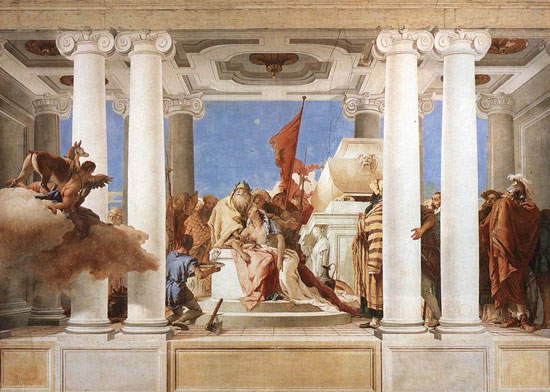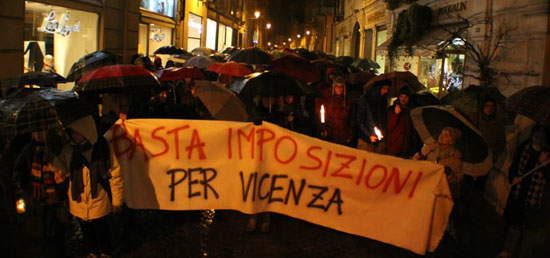Vicenza: masterpieces of Palladio and Tiepolo at risk because of HST
It is very difficult to understand why, in Italy, the interests of culture should be put on the back burner compared to other kinds of interests, moreover, jeopardizing the safety of the artistic heritage, with all that this entails: decline in tourist flows, loss of international prestige and, above all, the risk of extensive damage to art. This is what is happening these days in Vicenza: discussions are taking place on the city section of the high-speed railway that will connect Milan and Venice. The salient point of the project is the construction of a tunnel that will run through Monte Berico and will come out right under the Villa Valmarana ai Nani, a Palladian masterpiece that houses wonderful frescoes by Giambattista Tiepolo, which we had also talked about in our podcast dedicated to the great Venetian artist.
 |
| Giambattista Tiepolo, The Sacrifice of Iphigenia (1757): one of the frescoes at Villa Valmarana |
And this obviously poses serious dangers to the safety of the villa and its artworks. It is worth remembering that Vicenza’s historic center and the Palladian villas are part of theUNESCO World Heritage Site: the organization was already alerted in December, and the response was not long in coming. Indeed, UNESCO sent a letter to the municipality asking for explanations about the project, which must comply with constraints and standards in order for Vicenza to remain on the world heritage list. And this is not the first time that Vicenza has been discussed for acts against its heritage: for months, for example, there has been discussion about the impactful building projects in Borgo Berga that mix unclear interests and will heavily affect the city’s urban, landscape and hydrogeological layout.
And, going back to the HST, if the tunnel is not enough, there is also a project involving stations: the current one will be decommissioned (and to think that the redevelopment work has just finished!) and two new ones will be built, one in the fiera area (a decentralized area that needs to be redeveloped), and another in the Romeo Menti stadium area. Vicenza, in short, will no longer have a station within walking distance of the historic center, which will make it different from all major Italian cities: it will have one in the industrial area and another one that is a kilometer and a half from the Basilica, with accessibility problems when the local soccer team is playing, since the avenues in the vicinity are closed.
Now, it is not our intention to exhaustively summarize the whole affair, both because dozens of articles have come out in all the newspapers and because there are those who have done it better than we have (for example, the local newspaper Vicenza Today, the one that has seemed most active in following events, published an article in December explaining all the weaknesses of the project). As we said at the beginning, we would just like to understand why safeguarding culture should not be seen as a priority. Safeguarding culture does not mean saying no regardless to projects that could improve the lives of citizens. But this goal of improving the quality of life cannot be achieved if culture is not seen as a priority over other interventions.
However, the havoc that may affect culture is but one of the aspects to be reflected upon. Indeed, the TAV in Vicenza raises several questions: starting with why it is so difficult in Italy to improve and upgrade existing infrastructure, instead of creating new infrastructure, at exorbitant costs, and on which no sufficiently thorough studies have been conducted. Since we are talking about TAV, let us just recall the Reggio Emilia high-speed train station, built in the middle of the Po Valley, far from the city, costing 79 million euros and now largely underutilized compared to forecasts. Another very serious question concerns transparency: there are too many interests behind these works, many of them with unclear aspects, as the 5 Star Movement also denounces. Just think of the controversy that has arisen over the fact that the engineer who designed the Vicenza section of the HST also made a financial contribution, albeit not a large one, to the current mayor Achille Variati for his election campaign. And again, many of the areas traversed by the HST are subject to flooding: this is the case, for example, with the two new stations, which will be built in areas affected by critical issues. And finally, a no small question: citizen participation. It is unclear why these decisions continue to be made without real consultation with the opinion of the citizenry. We have already had occasion to say that an administration that does not take into account the opinions of its citizens, is an administration that does not respect its administered, and does not act for the good of the citizens.
Mayor Variati says that the project is not dropped from above. In the meantime, however, as we learn from a press release from the Vicenza branch of SEL, the majority of the City Council did not grant public consultation prior to the vote on the feasibility study, which was held this Wednesday and saw the majority prevail, with approval of the study. That within six months will become final project. However, the oppositions are not giving up and, together with a large part of the citizenry, are asking to participate in the discussion tables that will open before the project is approved in its final draft: there are still months to go. We can do nothing but support anyone who opposes the destruction of the Palladian landscape and cares about the fate of Vicenza, a city we are in love with (which is also why we feel this issue so strongly), and its inhabitants. The people of Vicenza appear very determined and are organizing, day after day, demonstrations and confrontations. Last night, for example, a torchlight procession was held through the city streets to protest the City Council’s decision not to allow public consultation before the feasibility study was approved.
 |
| Last night’s torchlight procession in Vicenza. Photo: No Dal Molin Permanent Presidium |
Those who want to learn more about the issue can visit the website of the VicenzaUrban/Territorial Observatory, a discussion table promoted by the Civiltà Verde association and the city sections of Italia Nostra and Legambiente, in collaboration with other local committees. On the website you can read all updates and find a comprehensive press review that is updated daily. Finally, this Monday, at 9:30 p.m., our usual tweetchat #artbtweets will be held on Twitter, and the theme will be “art in Vicenza”: there will also be room to talk about TAV, since the topics are closely related, so everyone who is interested in the subject is welcome!
Warning: the translation into English of the original Italian article was created using automatic tools. We undertake to review all articles, but we do not guarantee the total absence of inaccuracies in the translation due to the program. You can find the original by clicking on the ITA button. If you find any mistake,please contact us.





























